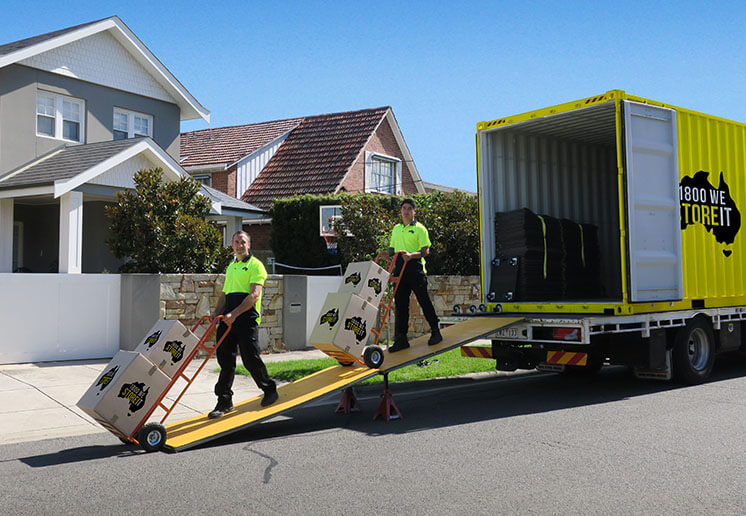Environmental Impact Mobile Storage vs Stationary Storage
Posted on 4 December 2023 | 4 minute read

Rising consumerism, the need for the next shiny thing, and increasing commercial rents have created a desperate need for residents and businesses to find extra square footage for storage that won’t break the bank. The self-storage industry has stepped in to fill the gaps for people needing more living space or businesses looking for cheap warehousing options.
If you are even the tiniest bit conscious of your carbon footprint on the planet, you’ve probably found yourself wondering about the environmental impact of self-storage. This article explores how self-storage and mobile storage affect the environment. When you understand the implications of your choices, you will be in a better position to choose the best self-storage solution for you and the environment.
Discover if shipping containers are secure here.
Environmental Impact of Stationary Self-Storage
Stationary or traditional self-storage spaces have a significant environmental impact that is not often considered when choosing a storage solutions provider. Let’s look at what these are and why they are worth considering.
Energy Consumption and Greenhouse Gas Emissions
Traditional self-storage facilities are notorious for their high energy consumption, especially for items that demand a climate-controlled environment. While many facilities adopt green energy solutions like solar panels, around-the-clock climate-controlled storage and lighting produce substantial greenhouse gas emissions while the sun isn’t shining.
Material Usage and Waste Generation During Construction
Stationary self-storage facilities require vast amounts of materials, leading to increased waste generation and depletion of natural resources. The production and transportation of these materials further contribute to carbon emissions. Additionally, waste materials disposal from construction and ongoing operations can negatively impact the environment if not managed properly.
Water Usage and Pollution
Conventional self-storage facilities require large amounts of water for cooling systems and maintaining cleanliness. This excessive water consumption can lead to water pollution if proper wastewater management practices are not in place. Expanding a facility as the business grows to service more customers contributes to urban sprawl, encroaching on valuable natural habitats and increasing the demand for water resources in already stressed areas.
Urban Sprawl and Habitat Encroachment
As the traditional self-storage facility industry grows and more locations open up, it often leads to urban sprawl, converting natural landscapes into developed areas. This encroachment on valuable habitats disrupts ecosystems and can lead to biodiversity loss. Urban development also leads to natural habitat fragmentation as native animals are forced into smaller areas as more of their natural pathways are cut off.
When you add energy consumption, material usage, urban sprawl, and waste generation to the equation, it’s clear that the cost of self-storage to the environment is not insignificant.
Environmental Impact of Portable Shipping Container Storage
If you are worried about your self-storage solution’s environmental impact, you will be pleased to know that mobile storage is a more sustainable alternative. Let’s check out why that is.
Energy Consumption and Greenhouse Gas Emissions
Compared to stationary self-storage facilities, portable shipping container storage generally requires less energy consumption. These containers are designed to be more energy-efficient, with insulation that helps maintain stable temperatures without relying heavily on climate control systems. As a result, the energy demand and associated greenhouse gas emissions are reduced, contributing to a smaller carbon footprint.
Material Usage and Waste Generation
Portable shipping container storage promotes utilising existing resources, which aligns with the principles of the circular economy. By repurposing shipping containers, which are often retired from their original use, the need for new construction materials is minimised. This approach reduces waste generation and the depletion of natural resources that would otherwise be required for constructing traditional self-storage facilities.
Water Usage and Pollution
Mobile storage solutions typically do not require large amounts of water for facility maintenance. As a result, the water consumption associated with portable shipping container storage is significantly lower compared to traditional self-storage facilities. This reduction in water usage helps conserve this valuable resource and minimises the potential for water pollution through wastewater management practices.
Flexibility and Reduced Urban Sprawl
One notable advantage of portable shipping container storage is its flexibility in terms of location. For example, mobile containers from 1800 We Store It can be quickly relocated to wherever it is most convenient. A storage unit on your driveway reduces greenhouse gas emissions as you no longer run loads across town in a gas-guzzling truck. Using existing spaces for storage, such as car parks and driveways, eliminates urban sprawl, giving our valuable fauna and flora room to grow.
Don’t let your storage solution put more strain on the environment. Choose the most sustainable solution by calling 1800 937 867 for a quick quote, or enter your details on our website, and one of our friendly staff will get back to you ASAP.


